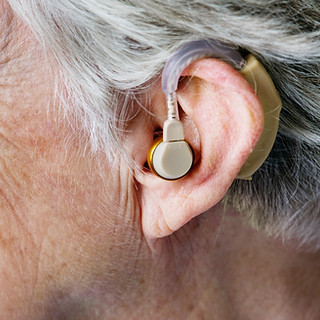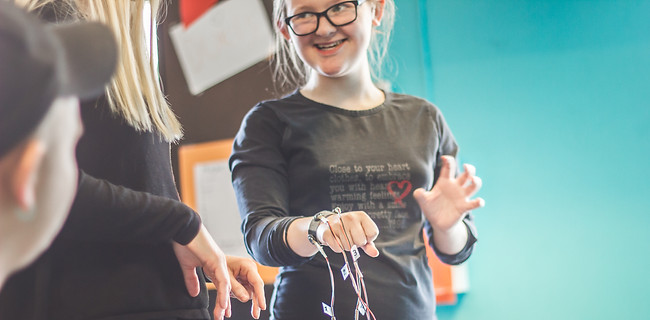top of page

Waveband
location
umeå university
master thesis
21 weeks
collaborator
dukis
year
spring 2019
This thesis project set out to empower people born deaf or hearing impaired in their everyday lives. An important aspect was to avoid a common fallacy - a solution designed from an audist’s perspective. Thus, the whole process was continually inspired by and validated with the target group: three people representing the spectrum of hearing impairment, a tinnitus group, and the youth center DUKiS for the hearing impaired in Stockholm. This resulted in a wearable that enables users to seamlessly get eachother’s attention through haptics - and if desired - take part in the everyday soundscape.
introduction | hearing through haptics
A short animation showing the two main aspects of the Waveband, and how they fit into the world of hearing impairment.
background | framing the issue

project inspiration
“When I put my hand on the speaker, I can still feel the beat. I love it!”
online comment, recently lost hearing
numbers on hearing loss
-
466 million people in the world have hearing loss, of which 34 million are children.
-
1.1 billion young people (12-35 years) are at risk for hearing loss due to recreational exposure to loud sounds.

in sweden
-
More than 1.4 million people have some sort of hearing impairment (including tinnitus, Meniéres illness etc.)
-
500 000 people have a hearing aid, although the amount should be around 800 000.
hearing impairment since birth

The device is surgically placed inside and behind the ear on children often between the ages of 6 months to 4 years old.
cochlear implants

Cochlear implants can help people with severe hearing loss understand up to 85% of conversations.
resistance from
the deaf community
Most babies are forced to adapt to a hearing family
You do not need hearing to be happy or successful
Cochlear implants have difficult learning curves
Deafness is often viewed wrongly as an abnormality
The implants are surgically invasive, thus risky
It's a loss of a member for the deaf community
Mild hearing loss
One can have difficulties hearing conversations in crowded areas.
Moderate hearing loss
Need hearing aid to converse without effort.
Severe hearing loss
Often relies on lip-reading and sign language.
Profound hearing loss
Need sign language, lip-reading or cochlear implants to converse.
levels of h.i.
first interviews | building a relation


As my knowledge of hearing impairment and deafness was close to zero, these girls generously told me about their whole journey, from birth until now, and how their condition has affected them and their families. We also talked about societal issues and relevant devices.
honest inside look

HRF (National agency for the hearing impaired)
Carola Hedmark runs a nonprofit Tinnitus Group in Umeå for HRF because she knows the need to discuss, share and learn with people in the same situation.
I met with her before a meeting to discuss my findings, pitch my ideas and get relevant feedback.

sensory substitution

Input from touch
Brain's processing capacity
Input from eyes
Input from ears
substitution
They are all the same to the brain, although after a while it figures out what they’re good for - input from the eyes is translated into seeing, and so on. In the case of losing one sense like hearing, the brain uses the same receptors to interpret input from other senses, like seeing, effectively leaving more capacity for the remaining senses.
electric impulses
If sounds are translated into, let’s say vibrations, in a predictable pattern during a longer period of time, the brain will process these vibrations as hearing.
workshop | insights and opportunities
Dukis
Stockholm’s only recreation center for young people between 11-17 years of age with hearing impairment. It’s meant to be a meeting environment for sign language users, which is to inspire the youngsters with different and independent leaders.



1 questionnaire
2 excercises
11 participants
workshop

These kids are happy, social, curious and like sign language. They do not need "saving".
main take-away



ethical approach
2 opportunity areas
+
empowerment
=
final direction
pick over
processing info
18 painpoints
+
10 insights
=
8 opportunity areas
8 opportunity areas
+
evaluation
=
2 opportunity areas
the brief
To design a device for getting attention for people born with severe hearing loss/deafness, which empowers their existing lifestyles. This gives me the chance to explore human senses and habits, and hopefully add value to society by improving life for minorities.


ideation | getting someone's attention
prototyping
Some basic mock-ups were made with simple material scraps, neodym magnets, 10 mm vibrational motors and an Arduino board.







user embodyment
I wore earplugs and hearing protectors for a day to get a better understanding of hearing impairment.


Final digital sketch before going into Rhino 3D
3D-printing helped to quickly test materials and dimensions
A sliding gallery with the user journey I used for validation
validation | scenarios




1/4
To explain the concept to myself, my mentors and to the enthusiastic people at DUKiS, I made a short visual comic where the most important aspects of the idea were portrayed in daily situations.
Check out the Slide Gallery above.
user scenarios



Luckily, the feedback on the scenarios and prototypes was over-whelmingly positive and encouraging.
validation

waveband | result

Everyday simple
It is meant to be worn often, hence the simple shapes and materials.
easy and friendly
Wireless charging aids water resistance, and simplifies the user experince. The battery lasts up to 10 days, depending on usage.



Designed for disassembly
Few components that are easy to take apart, and materials which are durable and recyclable/already recycled.
Waterproof
A strong requirement since the first interviews, as showering, swimming or walking in the rain is impossible with existing devices.

Touchpoints
Testing showed that distinct contact points were crucial for the user to understand which vibrator is active.

Interaction leds
The LEDs are usually off to make the device inconspicuous and less tech-y, but light up on interaction. White shows current mode, red indicates an alarm is going off and green is "ready for gesture input".

Mode 4
Full soundscape
Mode 1
Off (except alarms)
Mode 2
Signals / name
Mode 3
Loud sounds

Reacts to surroundings
The user can choose from four modes how much the device should react to sounds and nearby devices.
Signing is talking
Using hands is literally like speaking for sign language users, so activating the device with a personal gesture is like saying "Hey Siri"
Gesture activation
This helps integrate the Waveband seamlessly into their daily habits

Step 4
Their Waveband vibrates
Step 3
Point device at person
Step 2
Activate with gesture
Step 1
Need someone's attention

The app allows for people to change how they use the device, the vibration settings, which hand its on, the activation gesture etc.
customization

uid talks 2019 | exhibition



bottom of page
